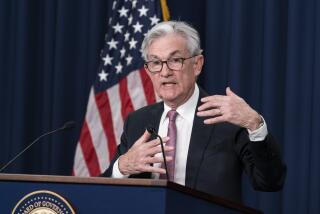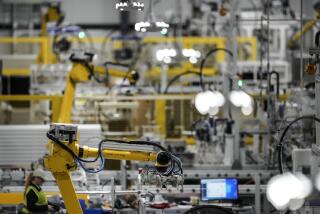Growth Is Up, So Why Are Some Worried? : Economy: Government’s 2nd-quarter figures show a solid recovery, but many investors fear that’s a sign of inflation.
The nation’s economy is showing signs of solid economic growth, dramatizing a growing divide between Wall Street and the business community over whether interest rates should rise further.
Housing sales have been brisk, unemployment claims have fallen and economic growth this spring was stronger than previously reported, government reports released Thursday indicate, but investors reacted negatively, driving down both the stock and bond markets.
The Dow Jones industrial average slipped 23.55 points to close at 3,854.63, and the bond market fall sent long-term interest rates higher again--the latest signal that investors believe an expanding economy is likely to spark inflation in the coming months.
The growth pace “will keep the inflation embers burning and the Federal Reserve uneasy,” said Robert G. Dederick, chief economist at Northern Trust Co. in Chicago.
Although many on Wall Street may welcome higher rates, some players in the economy are increasingly uneasy about raising rates to combat an inflation problem they say does not exist.
Indeed, some manufacturing executives believe interest rates have reached the level at which any further increase could jeopardize the economic recovery, said Jerry Jasinowski, president of the National Assn. of Manufacturers in Washington.
Moreover, lagging regions--notably Southern California--may have much to lose if rates jump another percentage point beyond the rise of roughly two points since the year began.
“Interest rate increases thus far have not had a significant deleterious effect on the private sector,” said Charles Woodford, an economist and executive vice president of Sanwa Bank in Los Angeles. “But any further increases should be viewed as a significant danger signal.”
The statistics released Thursday seem to show an economy that continues to move forward, albeit more slowly than it was late last year, analysts said.
Overall, the U.S. recovery proceeded at a 4.1% rate in the second quarter, according to an upward revision of the nation’s gross domestic product. The Commerce Department had previously estimated the rate at 3.8%.
Much of the gain, however, was caused by an accumulation of farm inventories, a transitory phenomenon that suggests slower growth in the third quarter, which ends this week.
In another sign of growth, the number of workers seeking unemployment benefits declined last week, the Labor Department said in a report that suggests a strong labor market. It was the fifth such decrease in six weeks, with claims falling by 11,000 to a seasonally adjusted 310,000.
In addition, sales of new homes posted a surprising jump in August, despite rising interest rates, the Commerce Department said, largely reflecting a surge in the Northeast. Total sales jumped 9.7% last month to a seasonally adjusted annual rate of 703,000, the biggest monthly rise in nearly a year.
“The economy has lost a step, but even so, it’s still moving ahead at a good clip,” Dederick said.
That leads to the conflict between Main Street U.S.A., which wants expanding job opportunities, and Wall Street, where investors stand to lose money if inflation re-emerges.
A recent poll by the National Assn. of Manufacturers, for example, found that 85% of 115 of its board members either opposed an interest rate increase or considered the timing premature. Jasinowski, the group’s president, said Thursday that the Fed and many investors are holding on to an outdated view of inflation that maintains that a growing economy inevitably sparks price increases.
Rather, goes the argument, in today’s world of global competition, cost cutting and productivity-enhancing technology, growth may unleash less inflation than it used to.
Economists generally believe that inflation is running in the 3% range right now, with many predicting a creep toward 4% or more next year as the recovery grinds on and shortages of labor and materials become more apparent.
Still, at least one economist said the Fed would be wary of hiking rates further, out of fear of wrecking the recovery.
“A lot of people on Wall Street would like the Fed to tighten till the economy is on the brink of recession,” said Joe Lavorgna, an economist at UBS Securities in New York. “But I don’t think that’s the Fed’s policy. It’s Main Street’s turn” to benefit from economic growth and jobs.
The more common view, however, is that a further hike is inevitable, perhaps at the mid-November meeting of the Fed’s rate-setting Open Market Committee.
“I would have expected a little more sign of cooling off than we’ve had” from previous interest rate increases, said Lyle E. Gramley, consulting economist with the Mortgage Bankers Assn. and a former governor on the Fed.
“If the numbers continue to come in strong, I’m quite confident they’ll increase rates on or before Nov. 15,” he said.
Gross Domestic Product
Percentage change from previous quarter:
Second quarter 1994: +4.1
Source: Commerce Department
New Home Sales
Seasonally adjusted annual rate, in thousands of units:
August 1994: 703
Source: Commerce Department
More to Read
Inside the business of entertainment
The Wide Shot brings you news, analysis and insights on everything from streaming wars to production — and what it all means for the future.
You may occasionally receive promotional content from the Los Angeles Times.










